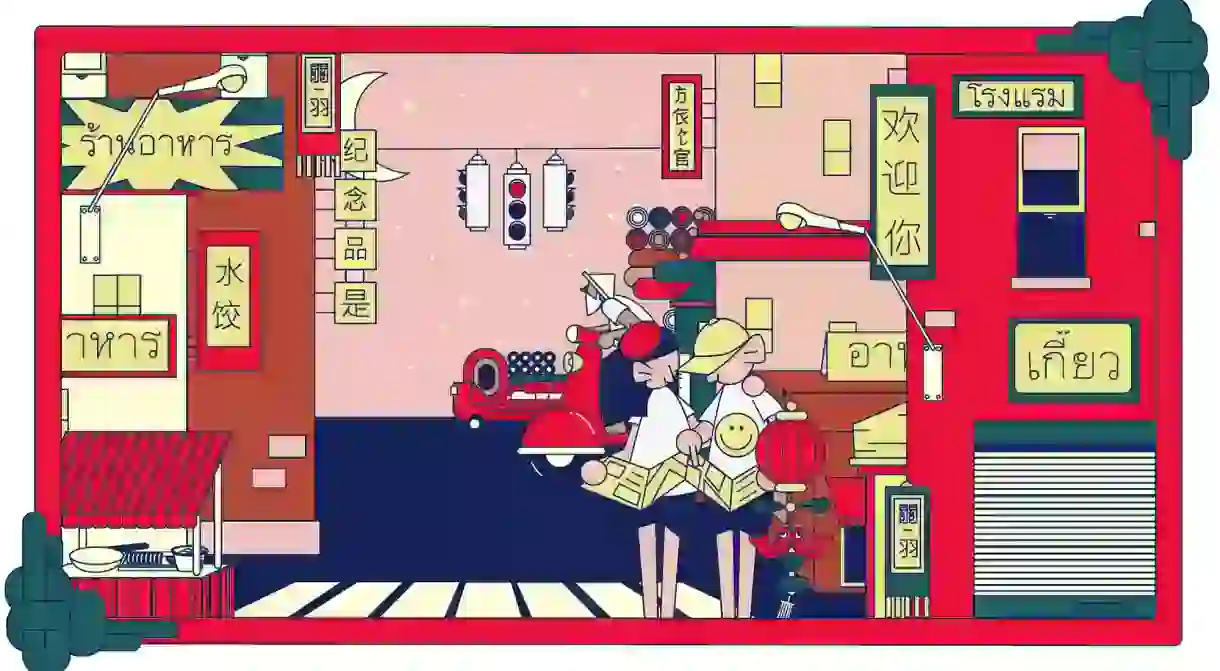Chinatown: Bangkok's Yaowarat Enshrines 700 Years of Chinese Heritage

Thailand’s Chinese heritage is knitted almost indiscernibly into the country’s culture. Yet in Bangkok Chinatown – known locally as Yaowarat – a distinctly Chinese identity endures.
Every morning, before dawn, members of the Worapong family rise to make the dumplings. The scent of ground pork sizzling with white taro and undisclosed spices fills their shophouse kitchen and steams into the alley out front, signalling to neighbours that a new day has begun.
The family is one of many in Yaowarat, as Bangkok’s Chinatown is known to locals, that is keeping a multigenerational business alive. The Worapongs first arrived in Bangkok with little more than their recipes. They spoke Teochew, one of the most common Chinese dialects among early arrivals to Yaowarat, along with Hokkien, Hakka, Cantonese and Hainanese.
“My family started selling khanom jeeb here about 100 years ago,” says Onsirisakun Worapong, using the Thai words for the savoury bite-sized pork and shrimp dumplings that his family has become well known for in Yaowarat. “It started with my great-grandparents almost immediately after they arrived here from China. Then it passed to my grandparents and finally to my father, Pracha.”

Still the face of the business, 77-year-old Pracha, or Pae Sia to use his nickname, hawks a daily quota of 3,000 handmade dumplings from a push-cart steamer that he parks at the gate of the Wat Mangkon Samakon temple. Fetching 3 baht (7p) a piece, the dumplings usually sell out by late afternoon, providing enough income for the entire family to live. While Pae Sia is something of a local celebrity, Onsirisakun quietly keeps the dumplings moving from kitchen to cart to the tables of dedicated patrons.
Other long-running Yaowarat businesses focus on traditional Chinese herbs, lucky talismans and gold jewellery. Some, such as those in the Charoen Chai neighbourhood, craft the paper offerings torched as gifts to the dead at Chinese funerals. On Sampeng Lane, fabric outlets join shops stuffed with cosmetics and hats, fluffy slippers and hand-held electric fans for cutting the heat of Bangkok. Here, the mostly imported products are always changing to satisfy shifting consumer tastes.
Down in Yaowarat’s Talad Noi neighbourhood, repair shops keep old Vespa scooters sputtering around town. Shophouse factories carve up ice bound for stalls that sell grass jelly (lod chong) in icy coconut milk. It makes a refreshing dessert after duck noodle soup (ba-mee ped), deep-fried pork belly with rice (khao muu krob) or wok-fried wide rice noodles (kuay thiao kua gai). These are just some of the popular street dishes rooted in Chinese cuisines and perfected at Yaowarat.

Yaowarat: unique among Chinatowns
Some foreign travellers make the mistake of skipping Yaowarat because they assume it will be like the Chinatowns found in, say, London or New York City. Yet, more so than in most western countries, Chinese roots run extraordinarily deep in Thailand. Yaowarat bustles as a living symbol of the Chinese heritage that has been folded into the kingdom over the centuries.
Many of the Thai kings who ruled the Ayutthaya kingdom, capital of Siam (renamed Thailand in 1932), appointed Chinese merchants to positions of nobility. Taksin the Great, who successfully led the defence of Siam against a tenacious Burmese invasion before becoming king and moving the capital from the city of Ayutthaya to Bangkok in the late 1760s, was half Chinese. By the early 1900s, an estimated 50-75 percent of Bangkok’s population were Chinese. Following in the footsteps of the Chinese nobles of Ayutthaya, several of Thailand’s current billionaires descend from Chinese migrants.
Throughout Thailand, some ethnic Chinese have intermarried not only with ethnic Thai but also Mon, Lao, Shan, Vietnamese, Khmer and other ethnicities that are also woven into the kingdom’s diverse heritage. Nowadays, short-term travellers from China are easily distinguishable from the assimilated Chinese-Thai, whose families arrived generations ago and who, to the average visitor, look and sound no different from any other Thai.
Yet the ethnic Chinese residents of Yaowarat remain proud of their heritage, evidenced by the careful maintenance of shrines dedicated to Guan Yu, the iconic Chinese warlord, and Kuan Yin, the feminine Chinese embodiment of the bodhisattva of compassion. Chinese drums accompany a dragon parade during Lunar New Year. Held in September, the Vegetarian Festival features meat-free dishes preferred by Chinese Buddhists.

Bangkok’s Chinatown moving into a new era
Gradually, Yaowarat is changing. Many of the elders still speak Teochew with Pae Sia, but younger Chinese-Thai tend to know only a handful of phrases in their family’s native dialect. Many of them are leaving Yaowarat to seek opportunities elsewhere in Southeast Asia’s second-largest economy. Some take their family recipes and business acumen overseas.
In Yaowarat, Thailand may be missing a chance to protect what Unesco calls “intangible cultural heritage” – traditions and ways of life. Yet, while some of the area’s old businesses are vanishing, new ones are emerging and others that seemed on the verge of collapse have adapted to meet the challenges of an evolving economy.
The 70-year-old Lor Yaowaraj transformed from a tired old grocery shop into a stylish, photogenic store after a young family member led a renovation effort. Several funky bars have opened in recent years and turned Yaowarat into a nightlife destination. Founded by a Yaowarat native who returned home after working in a university, Double Dogs Tea Room serves high-grade Chinese oolong in a sleek space set right on Yaowarat Road.
As for the Worapongs’ dumpling cart, the long-term future is unclear. “My 20-year-old son is studying in university now, and I’m not sure if he’ll take over the business some day or not,” says Onsirisakun. “It will be up to him.”













